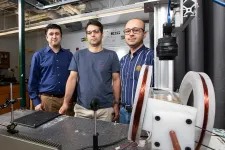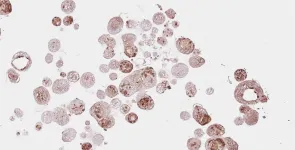Researchers identify a brain marker indicating future suicide risk
Changing the connectivity in this brain circuit with stimulation or pharmacotherapies could represent new treatments to reduce suicide risk.
2023-05-12
(Press-News.org) FOR IMMEDIATE RELEASE, May 12, 2023
Contact: Gina DiGravio, 617-358-7838, ginad@bu.edu
Researchers Identify a Brain Marker Indicating Future Suicide Risk
Changing the connectivity in this brain circuit with stimulation or pharmacotherapies could represent new treatments to reduce suicide risk.
(Boston)—Identifying people at high risk for suicide is critical for applying lifesaving interventions and treatments. However, it is very difficult to identify who is at greatest risk and only modest improvements has been made in identifying high risk people over the last 50 years. One novel way to identify people at high risk of suicide is by investigating and identifying brain markers.
VA and BU researchers have found that the functional connectivity between brain networks involved in cognitive control and self-referential thought processing, differed among veterans with a history of suicide attempts - even before they tried to end their life – when compared to those with similar levels of psychiatric symptoms, but without a suicide history.
“Our study provides evidence that this brain connectivity marker may be identifiable before a suicide attempt, suggesting that it could help identify those at risk for suicide. This could also lead to new treatments that target these brain regions and their underlying functions,” explained corresponding author Audreyana Jagger-Rickels, PhD, principal investigator in the National Center for PTSD at the VA Boston Healthcare System and assistant professor of psychiatry at Boston University Chobanian & Avedisian School of Medicine.
Participants in this study included post-9/11 veterans who participated in a longitudinal study at VA Boston Translational Research Center for Traumatic Brain Injury and Stress Disorders (TRACTS) that measures brain, cognitive, physical and psychological health. As a part of this study, veterans completed a “resting” functional MRI scan, which measures intrinsic communication between brain regions and networks. From this dataset, they identified a group of veterans who reported a suicide attempt at a one-to-two-year follow-up assessment but who did not report a suicide attempt at any of their previous assessments.
They then identified another group that had equivalent symptoms of depression and posttraumatic stress disorder (PTSD), but did not report a suicide attempt. Having this comparison group allowed the researchers to isolate brain connectivity associated with suicide attempts, rather than other factors like PTSD and depression. They then examined brain connectivity in the suicide attempt group before and after their suicide attempt and compared them to the matched control group. This comparison revealed that brain connectivity between cognitive control and self-referential processing networks was dysregulated in the suicide attempt group. Critically, this brain connectivity signature of suicide risk was present both before and after the attempt, suggesting that this brain marker may be a novel suicide-specific risk factor.
One of the challenges in suicide risk assessment is that it primarily relies on the method of self-reporting. “As a result, interventions to reduce suicide risk are limited to people who feel comfortable enough to disclose (self-report) suicidal thoughts and behaviors. Identifying measures that do not require self-disclosure of suicidal thoughts and behaviors may help us identify people who are overlooked, and may also aid in the development of novel treatments targeting the brain mechanisms underlying suicidal thoughts and behaviors,” said Jagger-Rickels.
The study also indicated that connectivity of the right amygdala, a brain region important for fear learning and trauma, differed between the suicide attempt group and the matched control group, but only after reporting a suicide attempt. “This suggests that there are brain changes that occur after a suicide attempt, which could be related to the stressors surrounding a suicide attempt or due to the trauma of the suicide attempt itself. This would indicate that suicide attempts themselves impact the brain, which could increase future suicide risk,” she added.
These findings appear online in the Journal of Affective Disorders.
This research was supported by the Department of Veteran s Affairs (VA) Translational Research Center for TBI and Stress Disorders (TRACTS), a VA Rehabilitation Research and Development National Network Center for TBI Research (B3001- C) to RM , a Merit Review Award from the VA Clinical Sciences Research and Development (I01CX001653) to ME , a SPiRE Award from VA Rehabilitation Research and Development (I21RX002737) to ME, a T32 post-doctoral training award from the National Institutes of Health (2T32MH01983621) and a Career Development Award from the VA Clinical Sciences Research and Development (IK1CX002541) to AJR.
END
ELSE PRESS RELEASES FROM THIS DATE:
2023-05-12
The spiral-shaped bacteria Helicobacter pylori are common and troublesome.
More than 13 percent of Americans have an H. pylori infection, although rates vary with age, race and socioeconomic status. The microorganism uses its corkscrew-like tail to power forward through viscous fluids such as stomach mucus. When it arrives at the epithelium of the stomach wall, it can cause everything from ulcers to cancer.
In a new study published by Physical Review Letters, FAMU-FSU College of Engineering researchers created a 3D model of this bacteria to better understand its movement, hoping to crack the code governing the organism’s motility ...
2023-05-12
Meeting the world’s energy demands is reaching a critical point. Powering the technological age has caused issues globally. It is increasingly important to create superconductors that can operate at ambient pressure and temperature. This would go a long way toward solving the energy crisis.
Advancements with superconductivity hinge on advances in quantum materials. When electrons inside of quantum materials undergo a phase transition, the electrons can form intricate patterns, such as fractals. A fractal is a never-ending pattern. When zooming in on a fractal, the image looks the same. Commonly seen fractals can be a tree or frost on a windowpane ...
2023-05-12
The plastic era has begun, and for sure, it will last for decades or even longer. Polymer-based materials are almost everywhere, reaching even the deepest regions of the oceans, and their global production is larger than recycling, leading to the generation of tremendous amounts of water pollution with microplastics. These tiny polymer particles not only release chemicals but also reduce the number of bacteriophages. Recently, researchers from the Institute of Physical Chemistry, Polish Academy of Sciences, led by Prof. Jan Paczesny, explored ...
2023-05-12
Researchers from the Organoid group (Hubrecht Institute) and UMC Utrecht have developed a biobank with organoids derived from patients with head and neck cancer (HNC). They used this biobank to validate known HNC biomarkers and found that treatment responses in the organoids matched those seen in patients. The results of the study will be published in Med on 12 May 2023 and could aid treatment decisions and discovery of novel therapies for HCN patients in the future.
Head and neck cancer (HNC) is an overarching term used for several types of cancer, including the most ...
2023-05-12
The bacteria present in the intestine provide information about the quantities of fungi of the potentially disease-causing Candida genus. Among them, and surprisingly, are lactic acid bacteria that are known for their protective effect against fungal infections. The findings of researchers at the Leibniz Institute for Natural Product Research and Infection Biology (Leibniz-HKI) and their collaborative partners from Denmark and Hungary add another piece to the puzzle of understanding the human gut microbiome.
The ...
2023-05-12
Alzheimer's disease (AD) is a progressive neurodegenerative disorder affecting tens of millions of people worldwide, and it is the most common cause of dementia. Early-onset AD is typically associated with mutations in the genes APP, PSEN1, and PSEN2, leading to a more aggressive form of the disease with atypical symptoms. In contrast, the newly discovered "Shanghai APP" mutation has been linked to LOAD, which affects a larger population of AD patients.
In a study published in Genes & ...
2023-05-12
The adverse effects of excess nitrate in water on human productivity and lives have received increasing attention due to the discharge of industrial wastewater and the overuse of farmland fertilizers. An international team of researchers has conducted an in-depth study of the significant need and challenge of efficient nitrate removal.
Several techniques have been used to eliminate nitrate from water, such as biological denitrification is technologically mature, cost-effective, and widely used. However, biological processes are often sluggish and ...
2023-05-12
□ DGIST (President Yang Kook) (the following three science and technology institutions) will establish a "Semiconductor Contracting Department" with Samsung Electronics for fostering technical staff specialized in semiconductor manufacturing processes.
□ DGIST closed a business agreement on the 27th (Mon) at DGIST University Center Convention Hall for establishing and operating the Semiconductor Contracting Department, which was attended by Samsung Electronics President Seokwoo Nam and Wanpyo Kim, DGIST President Yang Kook, and other major stakeholders.
□ Owing to the recently increasing global semiconductor demand, safeguarding national competitiveness ...
2023-05-12
□ DGIST (President Yang Kook) Professor Minseok Kim of the Department of Neurobiology and his team developed lossless immunocytochemistry technology, which facilitates analysis of rare cells that present in trace amounts in clinical specimens. The corresponding technology developed together with CTCELLS, Inc. involves the use of an ultra-thin film hydrogel to facilitate fluid exchange while inhibiting cell loss, and a higher preservation rate and reproducibility were achieved compared to existing cell ...
2023-05-12
Daegu Gyeongbuk Institute of Science & Technology (DGIST; President Kuk Young) and Seoul National University (President Ryu Hong-lim) signed a memorandum of understanding (MOU) on Wednesday, April 26 to develop an open innovation business model. Under this MOU, Senior Researcher Yun Jin-hyo at the Division of Electronics & Information Systems, DGIST provides consulting services required to develop an open business model to students in the Engineering Project Management Program at the Graduate School of Engineering Practice, Seoul National University. The first seminar was held on the day of the MOU.
□ Senior Researcher ...
LAST 30 PRESS RELEASES:
[Press-News.org] Researchers identify a brain marker indicating future suicide risk
Changing the connectivity in this brain circuit with stimulation or pharmacotherapies could represent new treatments to reduce suicide risk.




